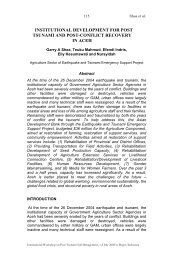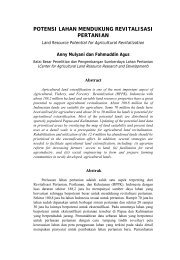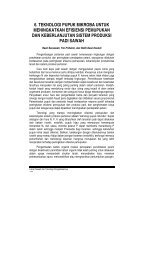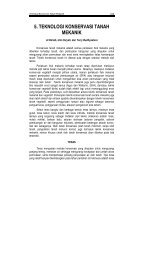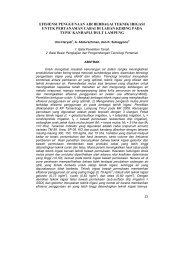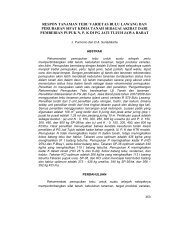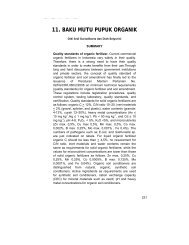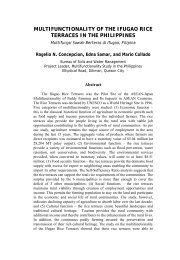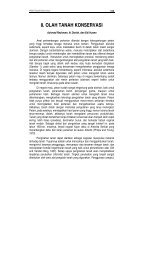Proceedings - Balai Penelitian Tanah
Proceedings - Balai Penelitian Tanah
Proceedings - Balai Penelitian Tanah
You also want an ePaper? Increase the reach of your titles
YUMPU automatically turns print PDFs into web optimized ePapers that Google loves.
55<br />
Rachman et al.<br />
Table 2. Characteristics of deposited mud measured in Aceh Besar,<br />
January,2005<br />
Soil properties<br />
Lamcot<br />
Sites<br />
Keneuneu Lampineung Tanjung Mire<br />
Thicknes (cm) 10-20 15-25 15-25 2-5 2-5<br />
Sand (%) 53 26 12 47 6<br />
Clay (%) 8 43 42 25 42<br />
ECe (dS/m) 60.9 84.2 80.1 38.9 19.8<br />
Salt (ppm) 31,280 46,268 44,116 20,140 9,804<br />
pHH2O 7.4 7.8 7.7 7.7 8.1<br />
Organic C (%) 2.9 4.1 2.3 1.0 2.8<br />
P2O5(HCl) (g/kg) 520 550 930 300 1420<br />
K2O(HCl) (g/kg) 300 1330 2560 730 2470<br />
P2O5(Olsen) (ppm) 64 60 48 27 115<br />
Ca (cmol(+)/kg) 24.7 20.1 18.6 8.6 18.9<br />
Mg (cmol(+)/kg) 6.9 24.5 26.2 10.8 19.7<br />
K (cmol(+)/kg) 0.5 2.2 2.9 0.8 2.4<br />
Na (cmol(+)/kg) 13.6 59.7 56.9 18.9 13.8<br />
Further survey was conducted on July 2005 to measure the thickness<br />
of the mud remain on the ground 7 months after tsunami.<br />
Approximately around 42,000 ha in Aceh Barat, Aceh Jaya, Aceh<br />
Besar and Banda Aceh of land are still covered by tsunami mud. The<br />
thickness varied from place to place with the largest areas covered by<br />
mud was in Aceh Jaya followed by Aceh Besar and Banda Aceh<br />
(Figure 2). The progress of the recovery process including<br />
reestablishment of drainage channels has been a major contributor to<br />
the reduction of tsunami mud remains on the agricultural land.<br />
Changes in soil salinity<br />
Less than one year after tsunami, most sites monitored in Bireuen (6<br />
out of 7 sites) and Pidie (4 out of 7 sites) have returned to normal<br />
condition (Table 3), other sites still suffered from either high electrical<br />
conductivity or high sodium concentration. After 18 months more sites<br />
(15 out of 20 sites) returned to normal levels of salinity. However,<br />
there were some sites where salinity persisted for a longer period of<br />
time, which may affect crop productivity. The recovery process of soil<br />
from salinity appeared to be related to the thickness of mud deposited<br />
after tsunami and restored farm activities. The areas inundated by<br />
sea water for less than 3 days were left with a thin layer of tsunami<br />
mud (



